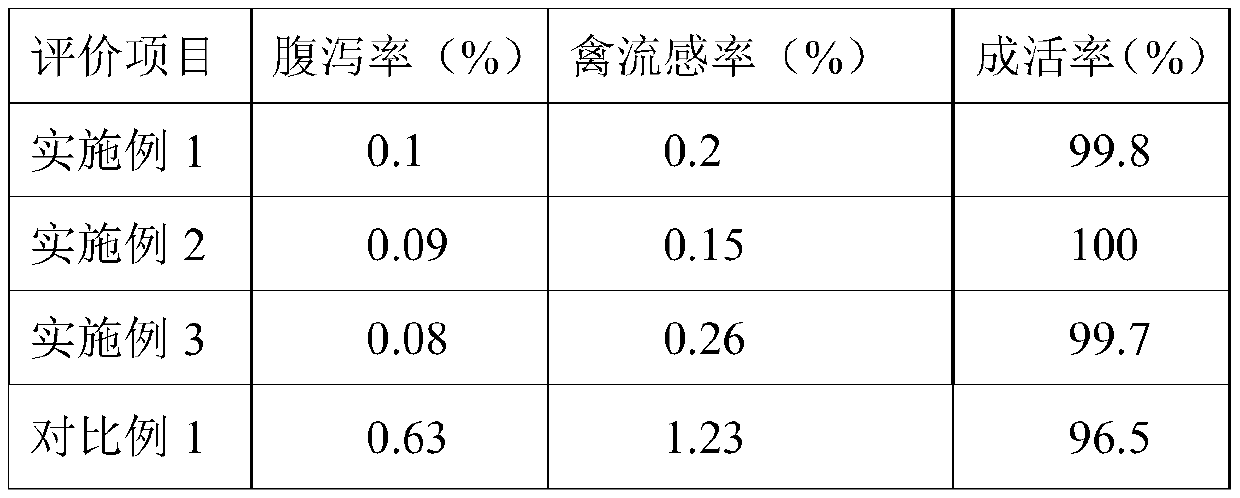Selenium-rich composite feed and production thereof
A technology of compound feed and production method, which is applied in the direction of animal feed, animal feed, additional food elements, etc., can solve the problems of hindering the normal growth and development of chickens, bottlenecks in the sales of agricultural products, and increasing the cost of agricultural products, so as to improve immunity and easy absorption , the effect of increasing palatability
- Summary
- Abstract
- Description
- Claims
- Application Information
AI Technical Summary
Problems solved by technology
Method used
Image
Examples
Embodiment 1
[0030] 2 parts of honeysuckle, 2 parts of chrysanthemum, 2 parts of coptis, 0.8 part of licorice, 0.8 part of Tianqi, 2 parts of selenium-enriched wine koji, 0.8 part of selenium-enriched yeast, 13 parts of wheat flour, 12 parts of silkworm chrysalis powder, 7 parts of wheat germ powder, bran 7 parts, 13 parts of fish meal, 12 parts of rice bran, 12 parts of corn flour, 23 parts of soybean meal, 0.1 part of trace elements, and 0.1 part of vitamins.
[0031] The trace elements include 0.015 parts of ferrous sulfate, 0.015 parts of copper sulfate, 0.015 parts of manganese sulfate, 0.015 parts of calcium iodate, 0.015 parts of sodium glutamate, 0.015 parts of zinc glycinate and 0.01 part of potassium iodide.
[0032] The vitamins include 0.012 parts of vitamin A, 0.012 parts of vitamin C, 0.012 parts of vitamin D, 0.012 parts of vitamin E, 0.012 parts of vitamin B, 0.015 parts of vitamin B2, 0.015 parts of pantothenic acid and 0.01 part of folic acid.
[0033] A production method...
Embodiment 3
[0048] 3 parts of honeysuckle, 3 parts of chrysanthemum, 3 parts of coptis, 1 part of licorice, 1 part of Tianqi, 3 parts of selenium-enriched wine koji, 1 part of selenium-enriched yeast, 15 parts of wheat flour, 15 parts of silkworm chrysalis powder, 10 parts of wheat germ powder, bran 10 parts, 15 parts of fish meal, 15 parts of rice bran, 15 parts of corn flour, 25 parts of soybean meal, 0.14 parts of trace elements, and 0.16 parts of vitamins.
[0049] The trace elements include 0.02 part of ferrous sulfate, 0.02 part of copper sulfate, 0.02 part of manganese sulfate, 0.02 part of calcium iodate, 0.02 part of sodium glutamate, 0.02 part of zinc glycinate and 0.02 part of potassium iodide.
[0050] The vitamins include 0.02 part of vitamin A, 0.02 part of vitamin C, 0.02 part of vitamin D, 0.02 part of vitamin E, 0.02 part of vitamin B, 0.02 part of vitamin B2, 0.02 part of pantothenic acid and 0.02 part of folic acid.
[0051] A production method of the above-mentioned sele...
PUM
 Login to View More
Login to View More Abstract
Description
Claims
Application Information
 Login to View More
Login to View More - R&D
- Intellectual Property
- Life Sciences
- Materials
- Tech Scout
- Unparalleled Data Quality
- Higher Quality Content
- 60% Fewer Hallucinations
Browse by: Latest US Patents, China's latest patents, Technical Efficacy Thesaurus, Application Domain, Technology Topic, Popular Technical Reports.
© 2025 PatSnap. All rights reserved.Legal|Privacy policy|Modern Slavery Act Transparency Statement|Sitemap|About US| Contact US: help@patsnap.com


